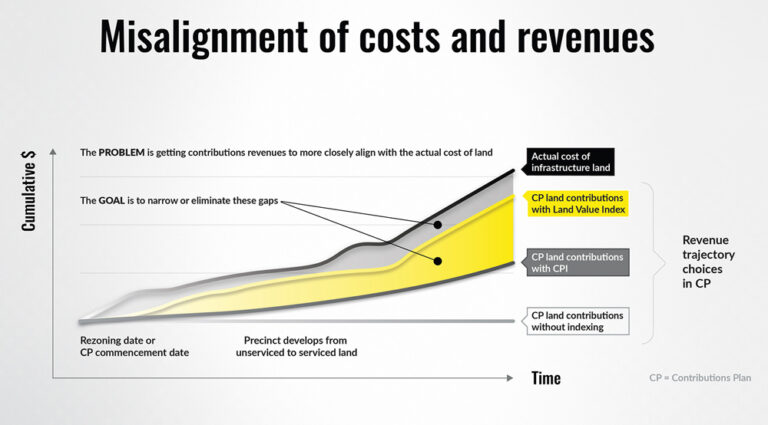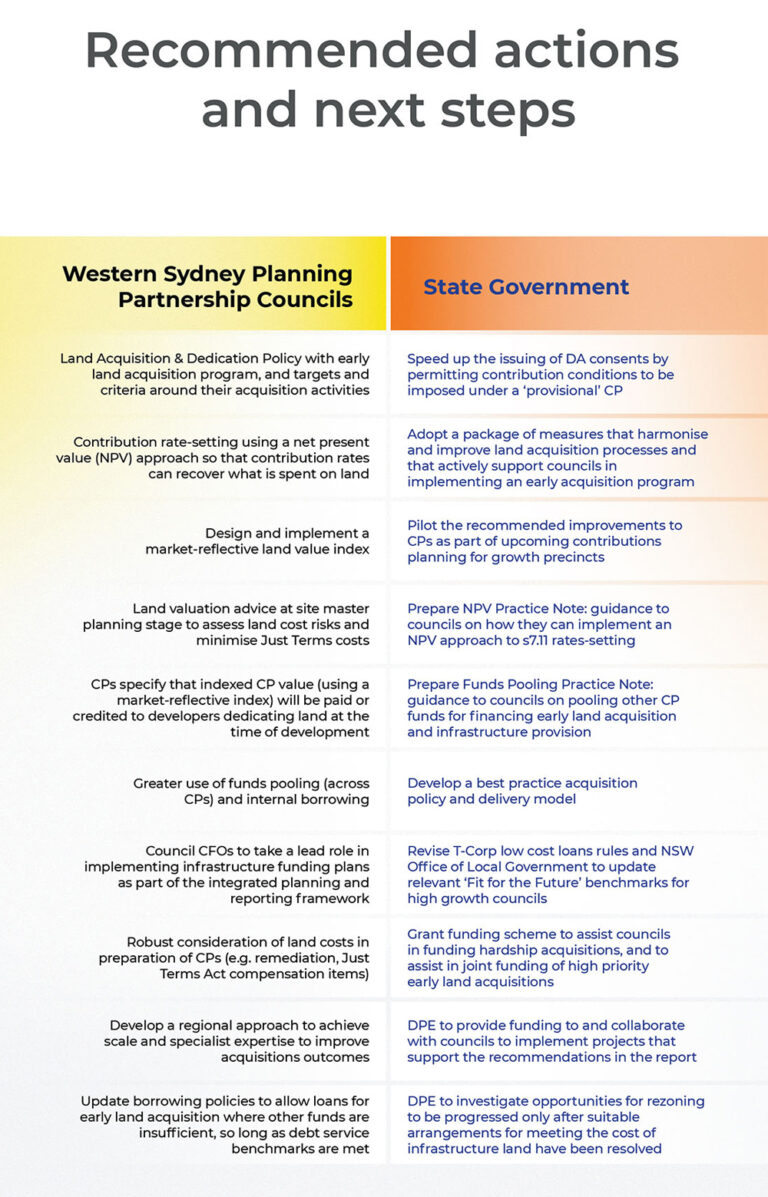Western Sydney Land Acquisition and Dedication Study
8 MAY 2023

Background
The Western Sydney Planning Partnership (the Partnership) is a local / State government vehicle for collaborative strategic planning for the Western Parkland City in Sydney. The Partnership councils represent some of the fastest growing areas of NSW, with the number of residents projected to increase by around 500,000 up to 2041.
However the rate of supply of new housing in Sydney has slowed to a level not seen since the Global Financial Crisis in 2008. The lack of developable land with adequate lead-in infrastructure has been cited as a major reason for this slowdown.
State government, utilities and local councils share the responsibility for growth area infrastructure. Councils are responsible for planning and delivery of local infrastructure including collector roads, drainage facilities, open space and community facilities.
Whereas State agencies and utilities are able fund infrastructure from consolidated tax revenue or annual user fees and charges, councils rely almost exclusively on cash contributions made by land developers (called s7.11 contributions after the section of the Environmental Planning and Assessment Act 1979 that authorises them). This reliance on a single funding source means often they are unable to meet the full cost of acquiring these lands.
GLN Planning and Atlas Economics were engaged by the Partnership to examine the local infrastructure land acquisition and dedication processes operating in their councils to develop strategies to address this funding risk.
Blue Mountains, Penrith, Hawkesbury, Fairfield, Camden, Campbelltown, Wollondilly, Liverpool councils¹. Blacktown council was included in this study because of that council’s extensive experience in acquiring land for growth area infrastructure.
What is the problem?
Infrastructure costs are made up of the costs of the infrastructure works, and the costs of the land that needs to be acquired from landowners by the council to provide those works.
Some local infrastructure such as parks and trunk drainage are particularly ‘land-hungry’, and the cost of acquiring infrastructure land can comprise anywhere between 50% and 70% of the total infrastructure costs in a typical Sydney greenfield area contributions plan.
Partnership councils often are unable to meet the full cost of acquiring the infrastructure land. This inability is driven on two fronts:
- Insufficient revenue collected through contributions plans, and
- High (often unanticipated) cost of acquiring privately owned land.
Put simply, the funds the council receives to acquire infrastructure land do not keep pace with the costs of acquisition. Chart 1 (below) shows this fiscal and temporal misalignment.

Chart 2 (below) shows the real impacts of revenue shortfalls – i.e. a self-perpetuating negative feedback loop of events characterised by delayed infrastructure, slow supply of serviced land, high land costs, and tepid housing supply.

Continuing on the current business-as-usual path represents a great financial risk for most of the Partnership councils. Without policy interventions, the funding gap between the total land costs in current contributions plans and the total expected contributions is conservatively estimated to be at least $480 million.
Causes
We found many factors are in play that are driving the misalignment. The major causes are listed below:
(a) There is a slow accumulation of contributions in the early years of the development. This is because s7.11 obligations do not fall due until the issue of the subdivision certificate for the new house lots, and certificates are issued after the lots have been connected to water, sewer and local road networks. It may be five or more years after a contributions plan has commenced that sufficient funds have built up to embark on a land acquisition process.
(b) Rate of price growth exceeds the index used in contributions plans, even when a customised land value index (or LVI) is used. The costs and revenue trajectories increasingly diverge and the gap worsens over time as development areas mature and there is a shift in the nature (and value) of land from ‘englobo’ to serviced land.
(c) The vast majority of councils use a ‘nominal’ method of rate-setting. This does not reflect the reality of cash flows – that expenditure (outflow) occurs ahead of contributions (inflow) that are received. A net present value (or NPV) approach is needed when councils are acquiring land ahead of the development curve. This recognises that a dollar spent today on infrastructure is worth more than a dollar collected in five years’ time in contributions.
(d) The price paid by the council to owners of land designated for infrastructure for acquired or dedicated land is usually ‘market value’. However, the funds collected via developer contributions are not reflective of ‘market value’, they are merely indexed from the rates that appear in the initial adopted plan.
(e) Compulsory acquisition under Just Terms legislation adds costs which are rarely or inadequately allowed for in the contributions plan. For example, severance costs. Beyond these processes, it is also common to find that that not all the costs required to enable the land’s future use for infrastructure purposes are included in the plan. For example, land remediation costs.
(f) In theory councils could borrow (internally or externally) to purchase strategic land for infrastructure that frees up development to occur. However they are restricted in the money they can borrow for growth infrastructure because of limitations imposed by State government as well as an entrenched culture of avoiding / minimising debt.
The drivers can be grouped into Revenue-side and Cost-side issues.
| Revenue-side | Cost-side |
|
Contributions collected later in the life of the plan, slow accumulation of funds Nominal approach to rate-setting Indexation not reflective of market movements |
Cost of land exceeds contributions value Shift in value of land from ‘englobo’ to serviced land Unexpected costs not provided for |
Recommended action and next steps
GLN and Atlas made a number of recommendations in the study for action by either councils or State government. They are summarised in Chart 3 (below).

Application of the complete package of policy interventions has the potential to significantly reduce and even eliminate the financial risks many councils currently experience in managing the land acquisition component of contributions plans.
Further and importantly, the interventions when implemented together have the potential to reduce the infrastructure land cost as land is acquired strategically and early in the development cycle.
The report has been adopted as a discussion paper by the Western Sydney Planning Partnership and is being considered for implementation by individual local councils into their contributions planning frameworks.
The Partnership has agreed to progress a number of joint projects to assist local councils with implementation of the recommendations, including work on:
(a) setting up NPV rate-setting approaches in contributions plans
(b) developing an effective LVI for inclusion in contributions plans
(c) designing early land acquisition programs in two pilot LGAs as the basis for the wider implementation of the early land acquisition approach for growth areas, and
d) developing a best practice guide for land acquisition for local government.
The financing of early land acquisition in growth areas ahead of the contributions coming in from development (item (c)) is a keystone action that will help unlock housing supply, provide greater certainty for affected land owners, and achieve the structural benefits for the contributions system outlined in the report (i.e. a clearer path toward alignment of costs and revenues). The early land acquisition program will require cooperation between local and State government to succeed.
The GLN and Atlas report can be accessed by clicking here.
1 Partnership includes; Blue Mountains, Penrith, Hawkesbury, Fairfield, Camden, Campbelltown, Wollondilly, Liverpool councils. Blacktown council was included in this study because of that council’s extensive experience in acquiring land for growth area infrastructure